Recent advances in soot combustion catalysts with designed micro-structures
Jiang Shao,Xianen Lan,Chaoxin Zhang,Chunmei Cao,Yifu Yu
a School of Chemical Engineering,Zhengzhou University,Zhengzhou 450000,China
b Institute of Molecular Plus,Department of Chemistry,School of Science,Tianjin University,Tianjin 300072,China
1 These authors contributed equally to this work.
ABSTRACT With the enhancement of the people consciousness of environment protection,soot particulates(PM)elimination has drawn wide attention in recent years.Efficient after-treatment with well-designed catalysts is one of the best ways to eliminate soot particulates that come from diesel engines.Catalysts coated on the DPF(diesel particulate filter)are considered as the main factor to lower soot ignition temperature.Improvement of the structures of the catalysts is significantly important in order to achieve good catalytic performance and high stability.Based on the structures,soot combustion catalysts can be mainly divided into three types:particle-based catalysts,3DOM catalysts and nanoarray catalysts.This review mainly summarized recent advances in soot combustion catalysts with different designed micro-structures,each category is explained with critical assessment and several typical examples,aiming to guide the synthesis of advanced soot combustion catalysts.
Keywords:Soot oxidation Nanoparticles 3DOM structures Active oxygen species Nanoarray structures
1.Introduction
Diesel engines have been widely used in our daily life.With the increase of diesel cars,soot particulates(PM)emission has attracted much attention.Emissions of diesel engines include PM,NOx,hydrocarbon,SO2,etc.,which are considered as harmful components to both environment and living organisms[1].The diameter of emitted PM from diesel engines is usually less than 10 μm[2],which leads to agglomerating easily in our lungs and increase the risk of respiratory diseases.Besides,the harmful chemicals PM,SO2and NOxcan cause smog,acid rain,light pollution,and a series of environmental problems[3].Therefore,for the sustainable development of environment,regulation of diesel emission is becoming increasingly stringent[4].Eu emission standards for heavyduty diesel vehicles are shown in Table 1.Based on the situation mentioned above,three ways to reduce diesel exhaust emissions will be discussed:choosing more proper fuels,modifications of the intrinsic structure of diesel engines and using more efficient aftertreatment methods[5].Among the above three ways,diesel exhaust after-treatment is the most economic and feasible measure,which gets paid special attention from relevant researchers all over the world.Combining diesel filters with catalysts for soot elimination is considered as a promising way to improve gas exhaust of diesel issues[6].Catalysts coated on the DPF(diesel particulate filter)are considered as the main factor to lower soot ignition temperature[7].At present,there are three main types of PM filter devices in commercial use,which are listed in Table 2[8].Generally,diesel engine exhausts consist of three phases with a high ignition temperature[9]and can be oxidized by oxygen at 600 °C without catalysts[10],however,it is quite hard for diesel engines to reach that temperature and eliminate soot particulates naturally[11].Therefore,it is necessary to develop catalysts by adjusting their components and structures to realize efficient soot removal[12].The role that catalyst plays in promoting the combustion of soot is shown in(Fig.1)[13].Relevant researchers have been dedicated to searching for all kinds of catalysts in the past two decades.An overview of catalysts used for soot combustion that recorded in literature is listed in Table 3[5,14].

Table 1 European emission standards(g/km).

Table 2 Three commercially available PM post-treatment filters.

Table 3 Catalysts(modification of components and structure)used for soot elimination.
J.P.Hesslaret al.[9]have identified the smallest diameter of the spherical soot is between 0.8-18 nm.Particulates produced by diesel engines exhibit small size and harmful effects[15,16].Catalysts for soot combustion need continuous improvement to maximize their catalytic efficiency,most of the current researchers focus on adjusting the composition and structure of the catalysts to improve their activity[17–20].In terms of modifying the catalyst composition,Atribak[21]used birnessite and cryptomelane instead of some commercial pure manganese oxides for soot elimination,among all the catalysts tested,birnessite and cryptomelane show a better catalytic activity than manganese oxides,such as MnO,MnO2.Similarly,the structure of the catalyst can be adjusted to improve its catalytic effect,the chemical form of perovskite catalysts is ABO3,where“A”usually represents an alkaline element,“B”represents a transitional metal.B-site ions are catalytically active[22].When loading the perovskite onto the foam base,the specific surface area and pore diameter of the catalyst will increase,which makes soot easier to contact the inner surface of the perovskite catalyst,thus improving the contact efficiency and enhancing catalytic activity.
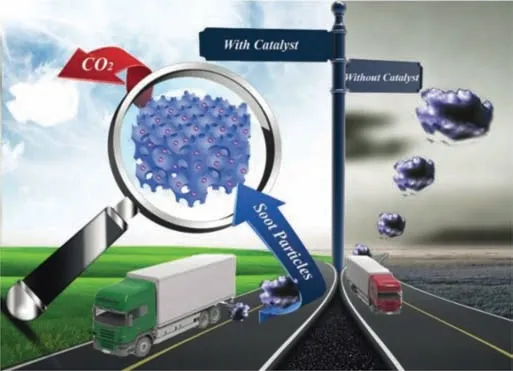
Fig.1.Schematic diagram of catalyst promoting soot combustion.Reprinted with permission[13].Copyright 2016,Royal Society of Chemistry.
Since current diesel engines are subject to many environmental standards,the internal structure of the diesel engine is highly corrected(Fig.2).Ways to reduce soot emissions by regulating diesel engines is more complicated[23,24].Therefore,an upgrade in the catalysts by adjusting components and structures to improve their ability for reducing exhaust emissions is essential.In this paper,we will summarize recent progress on modification of the catalysts used for soot elimination.
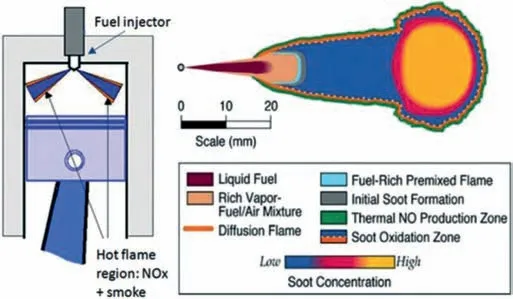
Fig.2.The typical model of a diesel engine.Reprinted with permission[5].Copyright 2017,Royal Society of Chemistry.
2.Particle-based catalysts
2.1.K-doping particle-based catalysts
Pollutants especially soot emitted from diesel engines contain harmful heterogeneous substances,thus effective elimination for soot with designed catalysts is important for the improvement of air quality and human health.Particle-based catalysts have been wildly studied due to their small size and good dispersion,they exhibited high activity and good stability.For example,supported oxide catalyst is economic and catalytically active under certain reaction conditions,but it does not behave well below 400 °C,the reaction for soot combustion would become sluggish.Noble metal catalysts also draw wide attention due to their excellent catalytic performance.However,noble metals such as Rh and Pt are expensive and easily deactivated due to sulfur poisoning[25].Recent studies show that alkali metal doping can promote the catalytic performance for catalysts mentioned above.
Particle-based and nano-structured catalyst doped with alkali metal K had obvious promotion effect on soot combustion.In most cases,K is used as an indirect medium to promote the formation of active sites.In addition,it could also be directly used as active sites.Supported metal oxides doped with nanoscale alkali metalsusually showed excellent catalytic activity.Liuet al.[26]reported a nanocomposite K-Co-CeO2catalyst prepared by MDC(microporediffused co-reaction)method,explaining the existence of potassium can promote the formation of activated oxygen species(O-),the participation of O-could stimulate the shift of the valence state of Co from Co3+to Co2+to form simultaneous oxygen vacancies which were confirmed by SEM,H2-TPR,and other characterization methods.Romelet al.[27]used the wet impregnation method to prepare K/MgO catalyst for soot removal.The catalytic performance was evaluated using carbon black as model soot.XPS characterization showed that the presence of K increased the oxygen content on the surface of the catalyst.X-ray diffraction spectrum showed that the loading of K on catalyst could also reduce the strength of Mg-O bond and promote the formation of active oxygen species on catalyst surface.These results indicated that K doping had a great promotion effect on soot elimination.Not only that,Min Sun[28]also confirmed that K can reduce the strength of Co-O bond and produce more active oxygen species.Zhang[29]employed the co-precipitation method to prepare the hydrotalcite-based catalyst with the doping of K to study its influence on soot combustion.It was proved that the Mg(Al)-O bond was weakened with the assistance of K doping,thus the fluidity of the active oxygen species was improved.Similarly,the research group of B.URA[30]also studied the advantages and mechanisms of K doping in hybrid oxides.Results showed that there were two mechanisms for the positive effects of K doping in strontium titanate:on the one hand,K doping improved the fluidity of the surface adsorbed oxygen;on the other hand,the formation of oxygen vacancies in the hydrotalcite-like structure was promoted with the assistance of K.Similarly,Qian Li’s group[31]successfully prepared the CoMgAlO catalystviathe coprecipitation method and supported a certain amount of K on it.They evaluated the catalytic performance for soot combustion,NOxstorage and NOxtransfer,respectively.Results showed that the catalytic activity was enhanced and the reduction temperature of NOxwas reduced.

Fig.3.Illustration of the unified oxygen spillover and the common electron transfer process for soot combustion on potassium-supported oxides.Reprinted with permission[24].Copyright 2014,Springer Nature.
In addition to the aspect of small-sized structure,conclusions mentioned above also showed that,alkali metal doping in nanoscale dimension played an important role in promoting soot oxidation.Recently,K+was confirmed as the active sites for soot elimination.Qian Li research group[32]synthesized three typical catalysts(MgO,CeO2and ZrO2)with different potassium doping contents,they all showed better catalytic effect compared to the corresponding single catalyst(Fig.3).Based on the characterization(XRD,XPS and IR spectra)results,active site K+and intermediate ketene were conducive to mass transfer and the formation of active oxygen species were observed.Besides,the existence of two kinds of potassium species(KOx,K2CO3)on these typical catalysts was identified.K could also accelerate the combustion of soot by promoting the formation of O-in nanoscale.Cao[33]synthesized a series of potassium loaded Co3O4nanowires(Co3O4-NW)on the monolithic nickel substrates by hydrothermal and wet impregnation method.The as-prepared catalysts exhibited higher activity than the corresponding catalysts without potassium doping.Results showed that potassium served as a kind of molten salt which not only enhances the contact efficiency between soot and catalysts but also increased the number of surface adsorbed oxygen species,thus facilitating the process of soot combustion.5% K loading catalyst(5K/Co3O4-NW)possessed the best catalytic activity withT10(279 °C),T50(324 °C)andSCO2(100%).These results indicated that K doping had a great promotion effect on soot elimination.
In this review,we also summarized the effects of alkali metal doping on catalysts with different structures for soot combustion,discovering that the reason why K doping could significantly promote soot combustion could be ascribed to seven aspects:(1)the melting point of K was low which is in favor for enhancing the mobility of the catalysts;(2)K compounds could form some low eutectic compounds to improve the activity of the catalyst;(3)the addition of K could generate more oxygen vacancies on the catalyst surface;(4)K doping made the active sites on the catalyst disperse uniformly;(5)K compounds promoted the formation of carbonate intermediate in the process of soot combustion,thus promoting soot consumption and improving its redox ability;(6)K compounds could capture and release the gases involved in soot oxidation;(7)K compounds provided a release route for CO2through the formation of carbonate intermediates.However,low thermal stability of K compound limited its application in practice.Improving support capacity was one of the effective ways to improve thermal stability of these kind of catalysts[34–43].
2.2.Particle-based catalysts with metal doping
Noble metal doping was similar to alkali metal K doping,both of which could promote the combustion of soot.This section focused on Ce-based catalysts and summarized the effect of noble metal doping on soot combustion.Similar to metal oxides,nanoscale metal doping on Ce-based catalysts also showed outstanding catalytic activity.Matarreseet al.[37]prepared ceria/zirconia-based(CZ)catalysts doped with small metal particles(Au,Fe,Ru and Pt)which served as active sites for eliminating pollutants.These catalysts all exhibited better performance compared to Pt-K/Al2O3because of their excellent NOxstorage capability.Ce-based nanostructure catalysts with the assistance of strong oxidizer O3could perform better in the process of soot combustion[44,45],the key factor to enhance catalytic activity was increasing the amounts of active oxygen O-[46].It was found that Ag/CeO2could produce much O-due to the promoted excessive oxygen vacancies[47].With the participation of O3and the modification of CeO2structure,the problems mentioned above could be solved properly.Zhang[48]synthesized Ag/CeO2catalysts with different structures(nanorod and nanocube).In the presence of strong oxidizer O3,extra O-were brought to facilitate the soot elimination(Fig.4).Moreover,the research group of Zhao[49]prepared Ce1-xZrxO2-supported gold nanoparticles catalysts successfully by GBMR method,showing thatT10andSCO2were remarkably decreased with gold nanoparticles coated on the internal and external surfaces of the catalysts,gold nanoparticles exhibited higher reactivity due to its special electronic properties.With the participation of gold nanoparticles,the pathway to activated oxygen species was changed(Fig.5).Oxygen was not only activated by Au nanoparticles on the surface but also the inner part of the catalysts with the synergistic effect between gold nanoparticle and support,which meant more activated oxygen species were formed to facilitate soot combustion during the reaction.
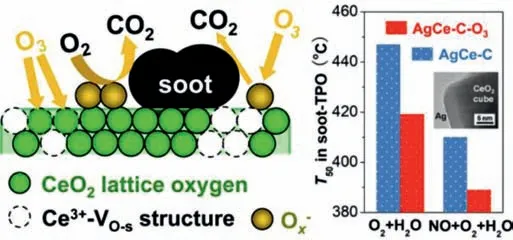
Fig.4.Mechanism and activity of Ag/CeO2 catalyst for soot combustion.Reprinted with permission[60].Copyright 2019,Elsevier.
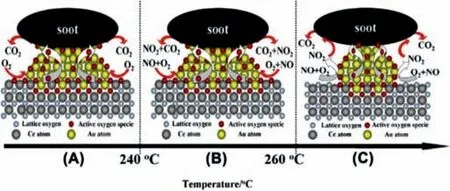
Fig.5.Mechanism illustration of 3DOM Au/Ce1-xZrxO2- catalysts used for soot combustion.Reprinted with permission[17].Copyright 2012,Academic Press Inc.
In addition to gold nanoparticles coated on Ce-based catalysts,the team of Zhao[50]also studied catalysts supported platinum nanoparticles on materials with MOF(metal-organic framework)structure.Zhaoet al.prepared Pd nanoparticles(Pd NPs)supported on MOF by wetness impregnation method,this catalyst showed high activity and stability,characterization results revealed that CO was completely conversed at 110 °C and the utilization effect of the catalyst was still excellent after five runs.Though Pd nanoparticle itself showed good intrinsic properties for CO oxidation,it may agglomerate on the surface of the catalysts during the process,which decreased the catalytic performance.MOF structure with interpenetrating channels could bind Pd2+tightly to prevent them from growing.Moreover,unique structure(MOF)combined with active components(Pd NPs)exhibited good synergy for soot elimination.Andanaet al.[51]also reported small Pt nanoparticles exhibited high activity,and they prepared Pt and Pt3Sn nanoparticles coated on ceria support by incipient wetness impregnation method to investigate their activities for NOx-assisted soot oxidation.Both Pt and Pt3Sn as the active sites could promote NO oxidation to produce more NO2which was beneficial for soot oxidation.Besides,it also revealed that the catalytic activity of Pt/CeO2-NCs(NCs stands for“nanocubes”)was similar to that of Pt3Sn/CeO2-NCs,the presence of Sn facilitates the formation of activated oxygen and reduced the temperature of soot oxidation.
3.3DOM catalysts
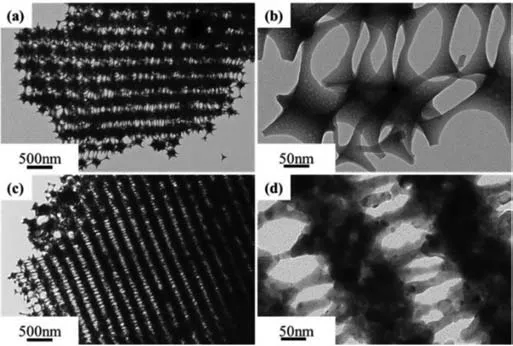
Fig.6.TEM images of(a,b)3DOM La0.8Ce0.2Mn0.6Fe0.4O3 and(c,d)K/La0.8Ce0.2Mn0.6Fe0.4O3.Reprinted with permission[13].Copyright 2016,Royal Society of Chemistry.
The improvement of the catalysts used for soot combustion mainly depends on two aspects.One is to modify the composition of the catalysts to increase their intrinsic activity,the other key factor is to improve the contact efficiency between soot particles and catalysts surface by designing unique macroporous structures.Traditional catalysts such as noble metals,metal oxides,perovskitetype catalysts,have smaller pore diameters(less than 10 nm)than soot particles(25 nm on average),so it is hard for soot to enter the inner surface of the catalysts to proceed deep oxidation.The contact area between soot and catalyst is highly responsible for eliminating diesel emissions.Therefore,the utilization of active sites is limited when the catalytic oxidation occurs only on the external surface of the catalyst.The preparation of a new type of catalyst with macroporous pores and well-defined structures is of vital importance for enhancing catalytic activity.Three-dimensionally ordered microporous(3DOM)materials with interconnected windows and macroporous pores(pore diameter>50 nm)are frequently reported in recent years.Catalysts with 3DOM structure could effectively enhance contact efficiency between soot particles and catalysts,full utilization of the inner surface area of the catalysts could produce more activated oxygen species to facilitate the combustion of soot.Given the advantages of 3DOM materials above,we herein propose a generalized summarization of current available 3DOM catalysts.The catalytic performances of some 3DOM catalysts are listed in Table 4.

Table 4 Summary of the performances of 3DOM catalysts.
The 3DOM structure of the perovskite catalyst ABOxshowed excellent performance for soot removal.Xuet al.[52]previously synthesized nanometric perovskite catalysts which showed good activity for soot combustion.To further improve its catalytic performance,they prepared LaCoxFe1-xO3perovskite-type catalyst with 3DOM structure by the method of colloidal crystal templates(CCT).SEM results revealed that this type of catalyst had plenty of ordered arrays and uniformly distributed pores(diameters>200 nm).The prepared catalysts exhibited high activity withT50(397 °C),SCO2(99.7%)by virtue of this particular structure.Mei[53]prepared 3DOM perovskite-type catalyst La1-xKxNiO3by CCT method.Results showed that K+and La3+were uniformly diffused and dispersed on 3DOM structure which could promote the contact efficiency between soot particulates and catalyst.The substitution of K for Ni enhanced the formation of surface oxygen vacancies which played an important role for soot oxidation.Among all the prepared catalysts,La0.95K0.05NiO3had the best catalytic performance.Similarly,Feng[13]synthesized La0.8Ce0.2Mn1-xFexO3and KNO3/La0.8Ce0.2Mn1-xFexO3successfully by the method of CCT and wetness impregnation,respectively(Fig.6).Catalysts were tested through a series of characterization(SEM,XRD,O2-TPD,H2-TPD and TEM).Results revealed that all the as-prepared catalysts had well-ordered macroporous structure which was favorable for soot to enter the inner pores to interact with active sites.The addition of K and Fe could improve the redox ability and the intrinsic properties of the catalyst for soot removal.
3DOM ceria-based catalysts also had a good effect on decreasing soot particulates emissions due to the formation of active oxygen and oxygen vacancies[54].In addition to the catalysts mentioned above,more and more perovskite-based catalysts were reported to be effective for environmental protections[55].Wei research group reported 3DOM Au/Ce1-xZrxO2-[49]and Pt-MnOx/3DOM-Al2O3[56]catalysts synthesized by gas bubblingassisted membrane reduction(GBMR)method and gas bubblingassisted membrane reduction-precipitation(GBMR/P)method,respectively.By modifying the porosity of the catalyst with 3DOM structure,they exhibited better activity in the process of soot oxidation compared to the corresponding small particle catalysts without ordered macroporous.Periodic voids and big pores brought by 3DOM structure provided accessible pathways for soot to interact with the inner part of the catalyst,thus increasing the number of contact sites which were highly responsible for the catalytic performance.Also,Yuet al.[57]reported a 3DOM MnxCe1-xOбcatalyst for soot oxidation prepared by CCT method,on which Pt was dispersed uniformly by the method ofin situreduction.Results showed that 3DOM Pt/MnxCe1-xOбhad better catalytic performance than the disordered nanometric samples.This kind of well-defined structure with uniform macropores(>300 nm)and interconnected windows in the inner surfaces could increase the contact sites and make soot access active sites flexibly.When x = 0.5,3DOM Mn0.5Ce0.5Oбexhibited the best catalytic performance for soot combustion.Moreover,the catalyst was further improved with the assistance of Pt particles.Pt/Mn0.5Ce0.5Oбhad excellent performance(T50andT90are 358 °C and 396 °C,respectively)in removing soot from diesel exhaust.Meanwhile,they also synthesized 3DOM SiO2and 3DOM K0.5MnCeOx/SiO2by the method of CCT and wetness impregnation,respectively[58,59].This type of catalyst had excellent catalytic property and thermal stability for catalyzing soot and NOx,which could be attributed to the unique 3DOM structure and the synergistic effect between K,Mn and Ce[60].
Transitional metal oxides(TMO)with varied valences showed good intrinsic activity for soot removal.3DOM materials with well-defined structure and uniform pore size(>50 nm)provided enough space for soot to enter the inner pores of the catalyst.Combining the nano-effect of TMO nanoparticles with the macroporous effect of 3DOM structure was a promising way to enhance catalytic performance for soot oxidation.Among all the studied catalysts,they all exhibited better catalytic performance compared to the corresponding nanometric samples,and 3DOM MnOx/SiO2exhibited the best performance withT50andT90are 355 °C and 393 °C,respectively.Similarly,3DOM Mn0.5Ce0.5Oδ/SiO2catalyst synthesized by Yu[61]by the method of wetness impregnation enhanced catalytic activity and sulfur resistance of the materials for soot combustion.Moreover,Caoet al.[62]also reported transitional metal oxide(Fe2O3nanosheets)loading metal Co supported on 3DOM nickel foam,they proved that the structure of 3DOM nickel foam could greatly improve contact efficiency between soot particles and catalyst,which was due to their well-ordered macropores with interconnected windows existing in the inner tunnels,the contact probability was remarkably enhanced due to the adoption of 3DOM nickel foam.Meanwhile,a new active phase named CoFe2O4was identified,Fe-O bond was lengthened due to the interaction effect between Co and Fe.For all the advantages above,the as-prepared catalysts with optimized Co loading 0.6 wt% exhibited the highest activity and good stability for soot combustion(Fig.7).Reaction mechanism of this type of catalyst was clearly studied.With the assistance of NOx,lower energy barrier was needed to be overcome for soot combustion.
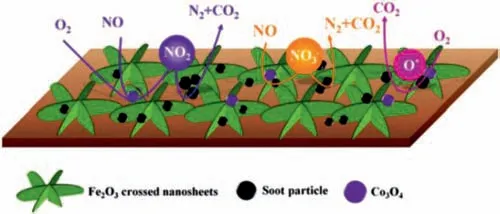
Fig.7.Illustration of reaction mechanisms for soot combustion over the xCo/Fe-NF catalysts.Reprinted with permission[73].Copyright 2017,Royal Society of Chemistry.
On account of the Ce-Zr interaction on 3DOM materials for the simultaneous purification of PM,the research group of Zhao[63]synthesized Ce0.9-xFe0.1ZrxO2catalyst with different Ce/Zr ratios by CCT method.3DOM structure of the as-prepared catalysts had inter-connected pores to provide more channels for soot to contact inner active sites.The introduction of Fe increased the ratio of Ce3+/Ce4+which could enhance the redox ability of the asprepared catalysts.Moreover,they also synthesized a similar catalyst(3DOM W/Ce0.8Zr0.2O2)by the same method[64],contact probability was remarkably strengthened with the unique macroporous structure.Ce-based oxide combined with Zr or zirconium oxide could increase oxygen storage ability and thermal stability of the as-prepared catalysts.The W addition promoted the formation of oxygen vacancies and active sites,the results of catalytic activity test showed that 3DOM W/Ce0.8Zr0.2O2has superior performance for simultaneous PM removal.In addition to 3DOM Ce/Zr,they also reported 3DOM Co-Ce mixed oxide catalysts for soot oxidation.Moreover,3DOM Co-based catalysts as MxCo3-xO4(M stands for Zn and Ni)were systematically studied by the research group of Deng[65],MxCo3-xO4possessed superior catalytic activity due to its well-defined structure and appropriate doping of metal M.The unique structure of the catalysts with highly ordered macropores and small interconnected windows highly improved the contact probabilities between soot and gaseous reactants.Meanwhile,with the doping of Ni or Zn to Co3O4,the energy needed for NO oxidation was decreased,thus promoting NO2formation which was of great significance to NOx-assisted soot oxidation.The synergy between Ce and Co enhanced the redox ability of the catalyst and formed more bulk oxygen vacancies than single Cebased oxide catalyst(Fig.8),and thus 3DOM CoxCe1-xOбcatalyst showed outstanding catalytic activity for the removal of NOxand PM from diesel exhaust[65–67].As shown in Fig.8,the mechanisms involved in the soot combustion were ascribed to active oxygen mechanism and NOx-assisted mechanism.O2was converted into O-and O-was subsequently catalytically with soot into CO2,meanwhile,NOxreacted with O-and soot to form clean gas components of N2and CO2.
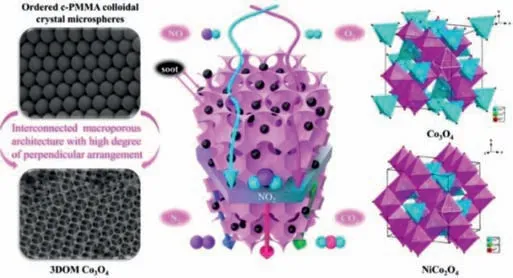
Fig.8.Illustration of 3DOM Co-based spinel catalysts.Reprinted with permission[64].Copyright 2019,American Chemical Society.
Conventional transition metal materials such as Fe-Mn based materials which were rarely reported in recent years were also effective for soot elimination[68,69].With the assistance of 3DOM structure,they surely could perform better than the corresponding catalysts with disordered structure[13,70].Tanet al.[71]synthesized disordered porous Fe-Mn oxide catalysts and 3DOM Fe-Mn oxide catalysts by solution combustion method and CCT method,respectively.A series of characterization results showed that the 3DOM catalyst had better catalytic performance with lower ignition temperature and more active oxygen vacancies than the corresponding catalysts with disordered structure.This unique special structure of 3DOM catalysts with interconnected windows and macroporous pores could provide channels to bind Fe-Mn tightly,even on the inner surfaces of the catalyst,which facilitated the interaction between Fe and Mn to increase the number of surface-active oxygen species and chemisorbed oxygen species to supply active sites for the soot combustion reaction.In addition to 3DOM Fe-Mn catalyst,Fe-based 3DOM catalysts such as Fedoped ceria catalyst,MFe2O4(M = Co,Ni,Cu)spinel catalyst,and La0.9Ce0.1Co0.8Fe0.2catalyst all exhibited excellent performance for soot oxidation[72–74].
As we all know,Pt-based catalysts possessed high activity and good thermal stability for soot combustion.However,high cost and the scarcity of Pt limited its practical application.A new alternative metal oxide(PrOx)with 3DOM structure could perform as well as Pt-based catalysts for PM and NOxremoval(Fig.9)[75].Virginiaet al.[76]prepared 3DOM PrOxby the method of CCT.Results showed that PrOxwas beneficial for NO converting to NO2,which was in favor of oxidizing soot at a low temperature.It was confirmed by mercury intrusion porosimetry that the pore-size of PrOx-3DOM was much larger than that of CeO2-3DOM,CeO2,PrOx,which increased the contact area of soot and catalyst.In addition,H2-TPR confirmed that the oxidation activity of NO to NO2was better than that of PrOx.The reason for this improvement was correlated to“active oxygen”,which was easily transferred to gas phase NO.Moreover,PrOxcould easily lose the oxygen at low temperatures,which was also conducive to the conversion of NO to NO2.The results of H2-TPR also confirmed that PrOxshowed better activity for soot combustion in the presence of NOx.
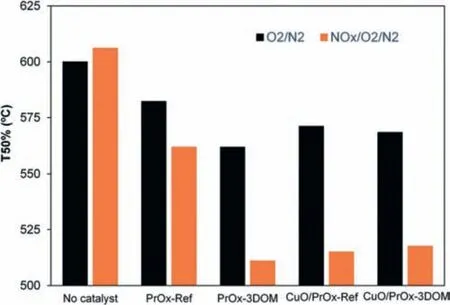
Fig.9.Summary of T50% of NOx-assisted soot oxidation of PrOx-based nanoparticles.Reprinted with permission[80].Copyright,2019,Royal Society of Chemistry.
The addition of the macroporous structure further enhanced the activity of the catalyst because it remarkably improved the contact efficiency between soot and catalyst.Also,3D ordered macroporous-mesoporous structure(3DOMM)with an ordered framework was beneficial for improving the contact efficiency between soot and reactants,thus enhancing the mass transfer for further soot oxidation[77–79].Xionget al.[80]prepared 3DOMM Ce0.3Zr0.7O2solid solution and 3DOMM Ce0.3Zr0.7O2-supported PdAu@CeO2catalyst by the method of EISA-CCT and GBMR,respectively.Results showed that macroporous structure and mesoporous architecture provided more contact chances and bigger surface area to increase surface density and active sites,moreover,the synergistic effect of Pd-Au-CeO2promotes both the formation of active oxygen species and NO oxidation to NO2.Therefore,3DOMM Ce0.3Zr0.7O2-supported PdAu@CeO2catalyst showed excellent properties for catalyzing the reaction between soot and O2/NO2.Moreover,Liuet al.[81]prepared hierarchical porous KOMS-2/3DOM-m Ti0.7Si0.3O2catalysts.The Ti0.7Si0.3O2supported contained ordered macropores and mesopores and the K-OMS-2 active phase contained micropores.The as-prepared catalyst with special structure showed excellent performance for soot combustion as well as high resistance to sulfur and water.K-OMS-2/3DOM-m Ti0.7Si0.3O2-450 exhibited best catalytic activity withT10,T50andT90values of 288,333 and 364 °C,respectively.The high catalytic performance in soot combustion was attributed to the hierarchical pore,a synergistic effect between K and Mn,as well as the doping with Ti.
4.Nanojrray catalysts
Over the past few years,the idea of enhancing the activity of the catalysts for soot removal through a slight change in the morphology and architecture has attracted wide attention.Reasonable modification over the architecture of the catalysts can increase the number of tangible active sites between soot and gaseous reactants such as O2,NO2[82,83],thus nanoarray catalysts with optimized architecture and well-dispersed active sites could also perform excellent catalytic activity as well as 3DOM materials.The catalytic performances of some nanoarray catalysts are listed in Table 5.

Table 5 Summary of the performances of nanoarray catalysts.
Based on the advantages of nanoarray catalysts mentioned above,a series of relevant researches were reported.Reports in-dicated that many transition metal oxides and rare earth metal oxides can be used for soot combustion.Thus,improving their structure and morphology to improve the performance of such metals had also been paid a lot of attention.Yuet al.[84]successfully synthesized CuO-based nanorods array with lawn-like morphology for soot elimination through the method of sequential chemical bath deposition(S-CBD)(Fig.10).The as-prepared catalysts with unique structure showed a remarkable effect for improving the contact efficiency between soot and catalysts.Moreover,they designed a new type of contact mode called gravitational contact mode(GCM)which was closely related to the practical situation for soot deposition.Based on the synergy effect of CuO-based array and GCM,combining with characterization results,they concluded that the CuO nanorods array performed better than CuO particles for soot oxidation.Furthermore,the CuO nanorods array could serve as a support to enhance the catalytic activity.In addition,the group of Yu[85]employed the method of anodization and light-assisted cyclic magnetic adsorption to prepare the TiO2nanotube array(TiO2-NA)and Fe2O3/TiO2-NA,respectively.The asprepared catalysts exhibited high activity and good thermal stability due to their specially designed architecture with domainconfined macropores,which were large enough for soot to enter the internal surface of the catalysts.Meanwhile,the Fe2O3/TiO2-NA catalyst showed a confinement effect which was favorable to accelerating soot oxidation.Based on the research mentioned above,Caoet al.[86]synthesized ultrathin ceria nanobelts array catalyst with a well-aligned structure,the as-prepared catalyst exhibited excellent catalytic performance under GCM because it had lots of surface defects(oxygen vacancies)and high potentiality to access soot.

Fig.10.Illustration of the mechanism for lawn-like CuO-based nanorods array for diesel soot combustion under GCM.Reprinted with permission[93].Copyright 2013,Royal Society of Chemistry.
Mn-based catalysts had been widely used in the field of soot combustion due to their strong redox ability(Mn2+/Mn3+,Mn3+/Mn4+)[87,88].It was noteworthy that the catalytic activity for soot elimination is closely related to the crystalline phase and morphology of the prepared catalysts[89–92].Therefore,a facile hydrothermal method was employed to synthesize mono and dopedα-MnO2nanowire arrays by the research group of Jampaiah[93].The as-prepared catalysts with special morphological structures greatly increased the number of active crystal planes and surface-absorbed oxygen species.Meanwhile,the presence of Cu and Co on MnO2nanowires facilitated the formation of active sites,so the catalytic performance for soot removal was remarkably enhanced.
Special structure(ceria-based support)of Pt3Sn/CeO2-NC catalyst demonstrated the importance on binding active sites which were easily to agglomerate,thus reducing the utilization effect of the catalyst.CeO2as catalyst support had been widely applied to the commercial field because of its intrinsic properties,different nanostructures(such as nanorods and nanotubes)could be easily formed by some incipient methods[94].Also,it was reported that the activity of nanostructured ceria-based catalysts for soot combustion highly depended on its morphology[95,96].Precious metals with high activity for soot combustion was limited due to economic reasons,not only that,they suffered a lot from poisoning and inactivating,with a lot of by-products produced in the process of soot oxidation[25,97,98].Therefore,searching for a welldefined substitute in non-precious metals was essential.Among all the transitional metals,copper had been investigated frequently due to its excellent sulfur resistance and remarkable stability for soot oxidation[99,100].The group of Piumetti[101]explored the properties of CuO nanoparticles supported by two different ceria morphologies(spongy and microstructured CeO2support)named as CeO2-SCS and CeO2-NC,respectively.Both Cu/CeO2-NC and Cu/CeO2-SCS showed better reducibility and dispersion compared to the single catalyst,which meant Cu NPS loading provide a good synergy for soot elimination(Fig.10).Also,it was revealed that Cu/CeO2-SCS functions better than Cu/CeO2-NC in the presence of NOx,contrary to the previous studies that“nanocube structure of ceria-based support possessed the best morphology”[102].
Except for nanocubes,catalysts with nanorod structure also got paid continuous attention due to their exposed active facets,which could promote soot combustion[103].La2O3was studied widely recently[104–106].Wu[107]successfully synthesized La2O3nanorod(La2O3R)catalyst with Pt nanoparticles supported by hydrothermal method.Results of catalytic tests showed that La2O3R had lots of active crystal facets,on which Pt nanoparticles(Pt NPs)were uniformed dispersed and stabilized.The interaction between Pt NPs and La2O3R was beneficial for the formation of active oxygen,which was closely related to the redox ability of the catalyst.
A slight change in the structure of the catalyst will improve its catalytic effect correspondingly,Xie[108]proved that Co3O4nanorods array have better performance for eliminating soot than Co3O4nanoparticles.Based on this conclusion,Liuet al.[109]prepared LaxK1–xCoO3nanorod for CO oxidation by sol-gel method,the as-prepared catalyst was characterized using a series of characterization methods,such as SEM,BET,XRD.Results revealed that LaxK1–xCoO3nanorod catalyst exhibited high activity,the rate of CO conversion could reach 100% at 200 °C.Besides,SEM results showed that more planes of the prepared catalyst are exposed,and the dispersion of active sites on nanorods are better than LaxK1–xCoO3nanoparticles.For the exploration of nanomaterials with the macroporous structure,Cao[33]prepared K doped Co3O4nanowires by hydrothermal and wetness impregnation methods,catalytic tests were carried out with the help of SEM,BET,XPS,and soot-TPR.Results showed that Co3O4nanowires structure could induce more space to increase the number of the contact sites between soot particulates and catalyst[33,110].Moreover,K could facilitate the formation of activated oxygen species,which was closely related to the catalytic activity.Moreover,for the research of small Fe ions,Gao[111]reported that the catalytic performance of Fe and Co co-doped ceria catalysts could be enhanced,because Co-Fe nanosized array structure could induce the formation of more oxygen vacancies,thus promoting soot oxidation.
5.Conclusions and future prospects
This review critically discusses different kinds of catalysts with unique structures for soot oxidation.Conclusions can be summarized in the following paragraph.
Three types of potential catalysts with different structures for soot combustion have been identified:particle-based catalysts,3DOM catalysts and nanoarray catalysts.
In particle-based catalysts,nanosized structure could improve the specific surface area and dispersion of the catalysts,thus improving their activity for soot oxidation.K doping not only affects the fluidity but also changes the physicochemical and catalytic properties of the catalysts.KNO3doping,for instance,has a double role on the catalysts for soot elimination:one is to serve as a kind of molten salt to enhance contact efficiency between soot and catalysts,the other is to increase the number of surface adsorbed oxygen species.
3DOM catalysts with uniform macropores play a key factor in both enhancing the contact efficiency and mass transfer between soot particles and catalysts.
Catalysts with nanoarray structures have optimized architecture,interconnected pores and well-dispersed active sites,which are highly effective for promoting soot oxidation.
Diesel engines occupy a dominant position among heavy-duty locomotives due to their high power,high fuel efficiency and low failure rate.However,the emitted soot particles have also become major environmental pollutants.Currently,diesel particulate filters can capture more than 90% of the soot.The biggest challenge of this technology is to make the soot catalytically eliminated at the temperature of diesel engine exhaust to realize thein-situregeneration of DPF.Therefore,the research on soot combustion catalysts is of great significance.Based on the latest developments in the soot combustion field,the main problems and challenges of the catalysts can be divided into three categories:
(1)Most catalysts are insufficiently active under low temperature conditions,thus it is difficult to eliminate the pollutants under stringent emission standards.Besides,most of the catalysts are limited to the elimination of one specific pollutant under complex flue gas,which makes it harder to achieve coordinated control of multiple pollutants.
(2)The mechanism of active oxygen species on the surface of the catalysts remains to be studied.The microscopic mechanism is helpful to the rational design of the catalysts.
(3)Due to the competitive relationship between O2and NOxon the surface of the catalyst,the selective catalytic reduction of NOxunder oxygen-enriched conditions is also a hot and diffi-cult problem in the soot combustion field.
(4)There are few reports on the engineering application of soot elimination catalysts.In order to realize the practical application of diesel engine exhaust purification catalysts,it is very important to further explore the engineering application of soot elimination catalysts.
Despite some existing challenges in this field,the growing interest in soot combustion catalysis indicates a promising future.More effort should be devoted to the designs of highly efficient nanomaterials and investigations into their reaction mechanisms.As the above challenges being solved,a great contribution will be made for the protection of the environment.
Declaration of competing interest
The authors declare that they have no known competing financial interests or personal relationships that could have appeared to influence the work reported in this paper.
Acknowledgments
Financial support provided by the National Natural Science Foundation of China(No.21808211),the Foundation of He’Nan Education Committee(No.202102210051)and the China Postdoctoral Science Foundation(No.2018M642787).
 Chinese Chemical Letters2022年4期
Chinese Chemical Letters2022年4期
- Chinese Chemical Letters的其它文章
- Key progresses of MOE key laboratory of macromolecular synthesis and functionalization in 2020
- Small nanoparticles bring big prospect:The synthesis,modification,photoluminescence and sensing applications of carbon dots
- Cell membrane-coated nanoparticles for immunotherapy
- Diketopyrrolopyrrole-derived organic small molecular dyes for tumor phototheranostics
- Exosome based miRNA delivery strategy for disease treatment
- Recent advances in targeted stimuli-responsive nano-based drug delivery systems combating atherosclerosis
